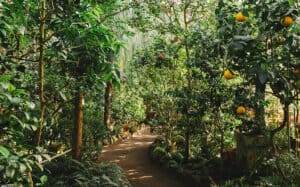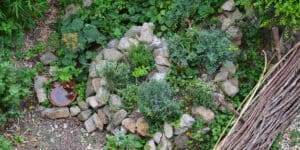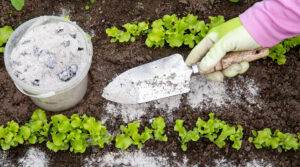Sheet mulching, sometimes called sheet composting or lasagna gardening, is a fool-proof strategy for suppressing weeds and building soil. By adding organic matter to the soil, sheet mulching eliminates the need for herbicides, tilling, and chemical soil additives. Harsher techniques, such as these, are generally more time-consuming and harmful to the helpful microorganisms that are important in healthy soil.
Sheet mulching is a soil-building strategy modeled after the natural actions on a forest floor. Leaves, needles, and other organic matter fall to the forest floor. This leaf litter mixes with nitrogen-rich organic matter, such as animal waste. It is decomposed into nutrient-rich fertile soil with the help of microorganisms without any human intervention. If this complex process sustains life without our help, why not harness this tool to improve the soil quality in your garden?
This soil improvement process can be as complicated as you’d like it to be. You could spend hours calculating the perfect carbon-to-nitrogen ratios to get the best combination of green and brown materials. However, a less strategic and time-consuming approach will produce similar results. As the business of our lives rarely decreases, give yourself a break and follow these five simple steps for optimal sheet mulch and soil health.
The Benefits of Sheet Mulching
A good sheet mulching strategy will generate rich, healthy soil in as little as one year with minimal labor compared to other soil-building methods. Most of the materials needed for this method can be sourced from your property or neighborhood, making it inexpensive. If low labor, healthy soil, and inexpensive materials aren’t enough to get you jumping on the sheet mulching train, perhaps one of these benefits will do the trick.
Suppresses Weeds
The cornerstone of sheet mulching is a thick weed barrier layer, such as cardboard, to stop weeds from growing up and through your sheet mulch. Weed seeds beneath the weed barrier are killed off instead of being unearthed through tilling. Sheet mulching can even limit the growth of hardy invasive species.
When the top layer of your sheet mulch is sturdy, as is the case with woodchips and straw, you will not need to weed your garden significantly for the first three years.
No Digging
When I first heard about sheet mulching, it was described as “the lazy way to garden.” I don’t believe in placing value statements such as laziness on any garden technique, but the message is there for a reason. Sheet mulching is, by far, the easiest way to build a new garden bed. It is possible to convert large areas into garden space in a day.
Sheet mulching does not involve digging, which makes it better for your body than other methods. Most materials used in sheet mulching are light, so many ages and abilities can participate in the project. Conversely, digging methods are limited to those with healthy backs and arms. For this reason, sheet mulching is the most accessible way to improve soil health.
Finally, sheet mulching can be completed any time of the year, even when the ground has frozen. Decomposition is surely slower during freezing temperatures, but the freeze-and-thaw cycle will speed things along come spring.
Builds and Maintains Soil Nutrients
You remove valuable nutrients when digging into soil or pulling out hardy weeds. Since sheet mulching suppresses most weeds, the soil can remain undisturbed to continue the healthy soil cycle. Digging up dirt disrupts the fertility-building process and causes the loss of organic material. Because this normal nutrient loss cycle is interrupted, sheet mulched gardens require fewer chemical fertilizers, which can interrupt the natural microorganisms in the soil.
Sheet mulching increases the amount of organic matter in your soil, expanding biodiversity. This process encourages the growth of worm colonies and other helpful soil organisms. When the soil has a high percentage of organic content, it is less likely to uptake heavy metals such as lead. Additionally, it diminishes toxins and encourages their disintegration.
Protects the Soil
Soil enhanced with sheet mulching protects the soil by reducing erosion and runoff. Any excess moisture gets pulled into the soil instead of running off your property and taking valuable nutrients. Instead, these nutrients remain in your soil to be slowly released over time and made available to plant roots.
In addition to protecting your soil from excessive water, good sheet mulching will protect it from harmful ultraviolet rays allowing it to maintain a more consistent temperature. Good mulching will keep your soil warm in the winter and cool in the summer. The soil will warm faster in the spring when you pull the top layer of mulch away from your plants and allow the sun to heat the soil.
Reduces Watering
As the threat of climate change intensifies, water shortages will increase. A garden built will sheet mulching reduces the need for watering. The organic matter in soil built with sheet mulching will act as a sponge, holding extra water in the soil and reducing the need for watering. As organic matter increases, so will your soil’s ability to retain water and grow healthier, more productive plants.
Sheet Mulching Science
Sheet mulching is just composting in place. The science behind composting is complex and involves the process of decomposition and fermentation. There are countless numbers of organisms involved, including bacteria, fungi, mold, and more. Despite this complexity, novice gardeners should not be deterred. The fundamentals are easy to understand, and the processes can withstand imperfection.
In short, organic matter decomposes into fertile soil when you combine carbon-rich material (brown) with nitrogen-rich material (green) at a ratio of 100:1 to 30:1. Brown materials include straw, dried grass clippings, wood chips, and fallen leaves. Green materials include manure, food scraps, fresh grass clippings, and bone meal. Layering these materials in sheet mulch allows them to break into fertile soil over time.
The following table gives ballpark ratios of common compost ingredients.
| Compost Material | Ratio of Carbon to Nitrogen |
| Bone meal | 12:1 |
| Dry grass clippings | 19:1 |
| Fresh grass clippings | 15:1 |
| Hay | 25:1 |
| Dry leaves | 50:1 |
| Fresh leaves | 30:1 |
| Wood chips | 600:1 |
| Straw | 80:1 |
| Sawdust | 400:1 |
| Seaweed | 19:1 |
| Vegetable waste | 12:1 |
| Chicken manure | 7:1 |
| Horse manure | 25:1 |
| Cow manure | 18:1 |
If you are like me, you may get bogged down in combining the perfect carbon-to-nitrogen ratios or agonize over sourcing the “right” materials. Let me save you some agony, do the best you can with the resources available to you. Even haphazard imperfect attempts at sheet mulching using subpar ingredients will result in fantastic fertile soil. When my life is at its busiest, I have been known to dump square yards of double-ground wood chips on top of cardboard and mix in a bit of bone meal. This careless attempt still results in excellent soil in about a year and a half.
Materials
Gathering the materials for sheet mulching is the most strenuous part of the job. You will need about four cubic yards of bulk material per 100 square feet of a finished garden bed. Try to collect materials that are natural in your area. For example, my city collects fallen leaves simultaneously every year. My neighbors readily allow me to hijack their leaves before the city truck comes along to pick them up.
Composting requires water to begin breaking down the raw materials into the soil. Select a site within reach of a hose or other water source.
You will need the following:
- Weed barrier to cover the area
- Broken down cardboard or
- 10 layers of newspaper
- Soil amendments (if needed)
- Bulk organic matter (shooting for 100:1 to 30:1 ratios)
- Straw
- Hay
- Soiled animal bedding
- Wood chips
- Dried grass
- Dried leaves
- Compost
- Composted manure or
- Composted food waste
- Seedless Mulch
- Straw
- Wood chips
- Pine needles
- Water
To soil test or not to soil test?
Some folks will recommend testing your soil before sheet mulching to help decide what soil amendments need to be incorporated into your plan. This makes sense, as sheet mulching is the perfect time to work added nutrients into the soil. Depending on your location, it may be easy and inexpensive to seek out soil testing from your local extension office.
If you have the time, energy, and money to test your soil, go for it. More knowledge about your soil is always better. However, whatever the outcome of your soil test, the most feasible solution to any soil nutrient deficiency is to add organic matter to the soil. The deficiencies exposed by a soil test can be remedied with a suitable sheet mulching strategy. In most cases, a soil test is added encouragement to build your soil with sheet mulch.
Step 1: Prepare the Site
Do not be tempted to rush into layering your sheet mulch. This is the perfect time to ensure sheet mulching success by amending, watering, and loosening your soil.
Loosen Soil
If your soil is clay dominant or compacted, as most lawns are, this is an opportunity to loosen it gently to allow the nutrients in the sheet mulch to seep deeper into the soil eventually. Using a garden fork or pitchfork, gently push the fork into the soil and move the handle back and forth, gently cracking open the soil.
The tiny cracks made by this process will allow water, nutrients, and microorganisms to move more easily between compacted soil and sheet mulch. We don’t want to dig or disturb the soil at all. If you don’t have the time and energy for this maneuver, this step can be skipped without consequence.
Water Soil
The night before sheet mulching, water your sight thoroughly unless it is already damp from the rain. The microorganisms that are responsible for turning your sheet mulch into soil require water to do so. By watering enough now, you will save yourself some time during the final step.
Slash and Drop Vegetation or Add a Nitrogen Layer
Any green vegetation present should be cut within two inches of the soil and left on, taking care to remove woody debris. This vegetation becomes the first layer of nitrogen-rich material in your sheet mulch.
If your site is bare and has no vegetation, you can add a thin layer of nitrogen-rich material such as composted manure, vegetable compost, or bone meal. This layer of nitrogen will be underneath your weed barrier and will encourage earthworms and other helpful organisms into your sheet mulch.
Amend Soil
If you plan to use soil amendments, now is the time to sprinkle them on top of your soil. They will go underneath the weed barrier. The results of your soil test will help you choose amendments. If in doubt, adding a bit of bone, feather, or blood meal is an excellent place to start.
Step 2: Weed Barrier
Lay down a weed barrier like cardboard, usually broken-down shipping boxes, or ten sheets of newspaper. The newspaper should be ¼ inch to ½ inch thick. This layer is important because it blocks the light from the ground underneath your sheet mulch, stopping weeds in their tracts. Overlap pieces of weed barrier by six to twelve inches. Weeds are persistent and will work their way up through gaps in the weed barrier.
After laying out the weed barrier, water it thoroughly until it is thoroughly damp. After your weed barrier is wet, don’t step on it to avoid compacting the dirt underneath and accidentally ripping the weed barrier.
Step 3: Layer Organic Matter
Finally! It is time to begin layering the organic matter. If you’re organized, layer the remaining materials in the following suggested order. If you are unorganized (I usually fall into this category), aim to layer your remaining materials until they reach a height of about one foot or more above your weed barrier layer. Even if you don’t get the layers perfect, you will still get good results and better soil than when you began.
Nitrogen Layer
On top of your weed barrier, sprinkle a layer of nitrogen-rich material such as compost or bone meal. This layer can be the same material that is underneath the weed barrier layer. The cardboard or newspaper you have used is likely the most carbon-rich material in your sheet mulch. Incorporating nitrogen-rich material on either side of it will help the weed barrier break down fast enough for micro-nutrients to move through and for eventual plant roots to move into the soil.
Bulk Organic Matter
On top of your nitrogen-rich layer, place eight to twelve inches of bulk organic matter. My favorites are straw and dried leaves because they are the most easily accessible to me. Note the carbon-to-nitrogen ratio of your chosen medium. If your material is high in carbon, like straw or wood chips, consider sprinkling in some bone meal to help your mixture reach an optimal carbon-to-nitrogen ratio for composting; 30:1 to 100:1.
As you construct this layer, water the organic matter periodically. Stopping to water as you go will save you time and water in the long run. You are looking for the dampness of a wrung-out sponge.
Compost
Next, place one to two inches of finished compost on top of your bulk organic matter layer. If you are planning to plant into your sheet compost this season, this is the eventual place you will plant seeds or plants. Compost is usually the most expensive and difficult-to-source material in sheet mulching. Regular garden soil will do if you don’t have enough compost to complete your project.
If you don’t plan to plant into your sheet mulch during its first season, you can omit this layer and wait until it has broken down into the soil before planting.
Step 4: Top with Seedless Mulch
Finally, top the sheet mulch with one to two inches of seedless mulch, such as wood chips, dried leaves, or pine needles. This layer gives your sheet mulch a finished look, reduces weeds, and protects the compost layer underneath.
If you cannot find an appropriate seedless mulch, using whatever you have on hand will also work. Soil that has been improved with sheet mulch is loose and fluffy, and any weeds that sprout will be easily removed. As the sheet mulch breaks down, you can add additional mulch. Keep weeds at bay by replenishing the top layer of mulch once per year.
Step 5: Water
Like all life, soil organisms need water and oxygen to survive. If the sheet mulch is too dry, the organisms inside will not have the water they need to do their job. Sheet mulch that is too wet will not allow enough oxygen to reach the organisms, impeding their metabolism.
Aim for 40 to 60 percent moisture in your sheet mulch. Using a hose nozzle in a gentle setting, spray down the entire sheet mulched area until it is the dampness of a wrung-out sponge. Avoid soaking the area with too much water, which could wash away essential nutrients.
Challenges and Obstacles
I hope by now I have convinced you to try sheet mulching in a home-scale permaculture environment. It is my favorite way to build soil, but it does have some challenges. Knowing the potential drawbacks ahead of time will prepare you to get the most out of your experience.
Planting in New Sheet Mulch
A new sheet mulched bed will reach maximum productivity in a year, but that doesn’t mean you have to wait before using it. Consider planting woody trees and bushes first before installing sheet mulch. Work around the new plants when you lay down your weed barrier layer, ensuring that the weed barrier layer is one inch from the base of the plant.
If you have a fresh layer of sheet mulch you would like to plant a deep-rooted plant into, simply dig a hole down to the weed barrier layer and cut an X into it. Place the plant’s root crown about an inch above the previous soil level. This will give the plants roots room to find the opening. Fill the hole with fertile soil. You can leave your sheet mulch and woody plants alone while the mulch breaks down before planting next season.
It is possible to plant tender plants in a new sheet mulched bed. Simply dig a trench through the top two layers (the compost and weed-free mulch) and fill it with the fertile soil of your choice. Sow seeds directly into this trench and care for them as usual.
Slugs and Snails
Slugs and snails may be drawn to your sheet-mulched bed by decomposing organic material. The layers of mulch make cozy hiding places where their next meal is easily within reach. You can compensate for slugs by planting sacrificial tender greens, such as lettuce or mustard.
Oversow these with the understanding that slugs and snails may do the thinning for you!
A healthy backyard ecosystem will attract birds that are natural predators of slugs and snails. On years when fresh sheet mulch has been installed, plan to add additional elements that attract birds. Releasing a few monitored chickens into your sheet-mulched area will also take care of a slug infestation.
Quick Recap!
Soil is the most important building block of a successful garden or food forest. Sheet mulching is a quick and easy way to build soil and suppress weeds. It is one of the least expensive and least labor-intensive ways to begin a new garden. Starting a garden with sheet mulch adds organic matter to the soil without needing herbicides, digging, or tilling.
The hardest part of sheet mulching is sourcing the materials. Take out the guesswork by following the five simple steps outlined in this article, and soon your garden will be reaping the benefits of sheet mulching.
References
Barber, L. R., Acosta, M., Wall, P., Cruz, F., & Denney, P. SHEET MULCHING.
Hemenway, T. (2009). Bringing the soil to life. In Gaia’s garden (2nd ed., pp. 80–91). essay, Chelsea Green Publishing.
Waldock, H. (2001). An Introduction to Permaculture Sheet Mulching. Vancouver, BC; Edible Landscape Creations and the Vancouver Permaculture Network.
Washington State University Extension. (2022). Compost Fundamentals. Fundamentals of composting: Why compost. Retrieved November 18, 2022, from http://whatcom.wsu.edu/ag/compost/fundamentals/








